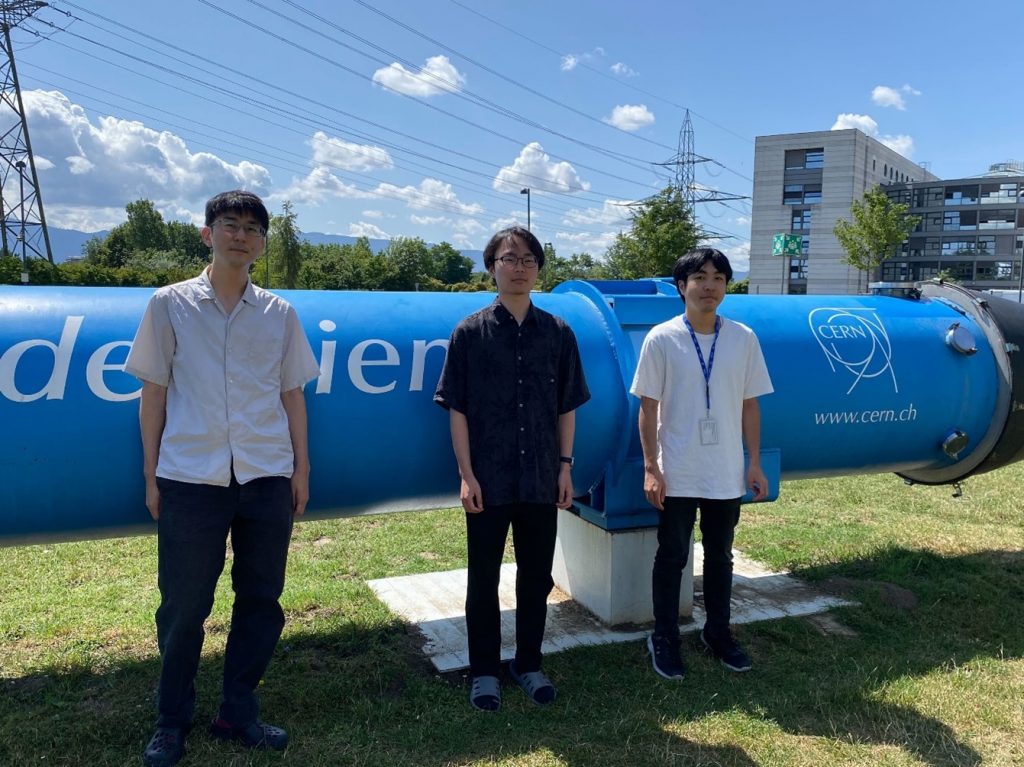2023.08.18
【WRH】Assistant Professor Yohei Yamaguchi visited CERN in Switzerland
Assistant Professor Yohei Yamaguch has returned from a 35-day stay in Switzerland supported by the WRH Faculty Research Abroad Program. This is a report on the activities and results of his stay.
 Dr.Yamaguchi(Left),Mr. Onoda/M1(Center),Mr. Ochi/D1(Right)
Dr.Yamaguchi(Left),Mr. Onoda/M1(Center),Mr. Ochi/D1(Right)
| Awardee | Yohei Yamaguchi, Assistant Professor, School of Science |
| Destination | CERN |
| City and Country | Geneva, Switzerland |
| Name and Position of Host Researcher | Savanna Shaw・Research and Technical Staff |
| Travel Period | 2023/06/29 – 2023/08/2 (35 Days) |
| Project Title | Development of data acquisition system for the ATLAS Experiment at the CERN-LHC |
I visited CERN, the European Organization for Nuclear Research, and developed the data acquisition system for the ATLAS experiment. The ATLAS detector is constructed at one of the collision points of the Large Hadron Collider (LHC), the world’s largest proton-proton collider. The ATLAS experiment must reduce the proton-proton collision data by a factor of 30,000 before recording. Thus, the trigger system needs to accurately predict interesting events in advance to record them. For the trigger system, when a new particle decays into two muons and these muons are close to each other due to the high momentum of the new particle, it is not so easy to separate the muons within a limited amount of time. Various new physics candidates predict such signals. Supersymmetry models are prominent theories that provide a good candidate for dark matter. In this study, I went to CERN where proton-proton collision data were acquired, and developed triggers for these two closely spaced muons.
I developed the basic design of the trigger with the support program for the promotion of joint international research by Tokyo Tech which provided travel expenses before this trip. However, after the LHC operation started, it was discovered by the collaborator Savanna Shaw that CPU costs for the trigger were significantly higher than our prediction. The data acquisition system runs 40,000 CPU cores online for data processing, and each event must be processed in the order of 100 ms. The introduced trigger was using an average calculation time of around 50 ms, imposing a burden on the data acquisition system. To address this issue, I developed an improvement to accelerate calculations while maintaining data acquisition efficiency. These improvements reduced the average calculation time to 14 ms. Conducting research activities on-site during LHC proton-proton runs allowed for dynamic conversations with collaborators and contributed to effective resolution of issues. The computational resources saved through this improvement were shared across the entire data acquisition system, achieving enhanced acquisition efficiency for a wide range of new physics signal candidates.
However, on July 18th, the LHC operation was stopped due to machine trouble, and not resumed yet. While the development of the close-by muon-pair trigger continues, the outcomes and feedback are not immediately available. Therefore, I collaborated with a master’s degree student from our laboratory who was on-site as well and embarked on fundamental research for future data acquisition systems. We focused on events where a Higgs boson decays into two photons and explored a new method for accurately reconstructing these photons online. Conventionally, the trigger system reconstructs photons only using calorimeter information, but the new approach combines information from the tracking detector as well. As photons are electrically neutral, they do not leave signals in the tracking detector. However, around 30% of photons convert into electron-positron pairs within the tracker, making these conversions reconstructible as tracks. Acquiring this information significantly reduces events where hadrons are mistakenly reconstructed as photons. Testing this trigger concept through simulations yielded promising indications for future improvements. Based on these results, discussions were held with local researchers, revealing the potential that this idea holds. If the trigger is realized, it could potentially shed light on the process by which the Higgs field underwent phase transition in the early universe, leading to the acquisition of mass by elementary particles.
Related links:
– World Research Hub (WRH) Program
–School of Science Kuze Lab.

